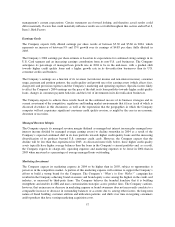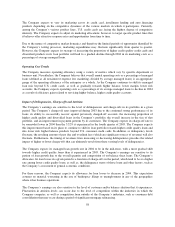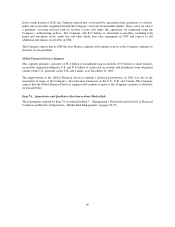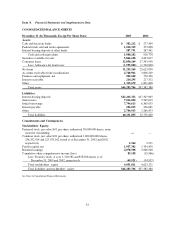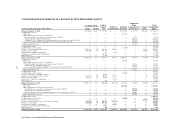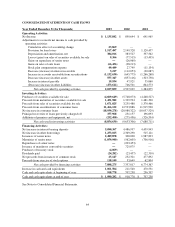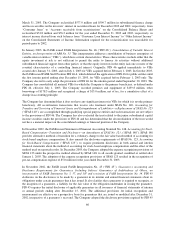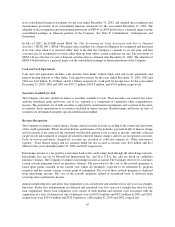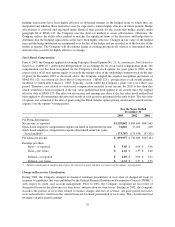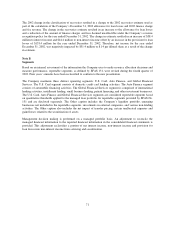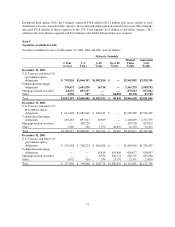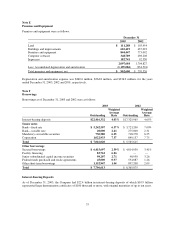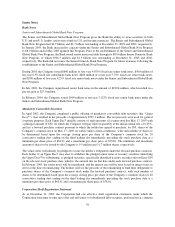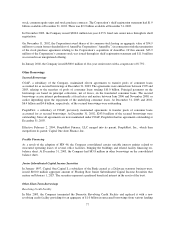Capital One 2003 Annual Report Download - page 85
Download and view the complete annual report
Please find page 85 of the 2003 Capital One annual report below. You can navigate through the pages in the report by either clicking on the pages listed below, or by using the keyword search tool below to find specific information within the annual report.in its consolidated financial statements for the year ended December 31, 2002, and adopted the recognition and
measurement provisions in its consolidated financial statements for the year ended December 31, 2003. The
adoption of the recognition and measurement provisions of FIN 45 in 2003 did not have a material impact on the
consolidated earnings or financial position of the Company. See Note P, Commitments, Contingencies and
Guarantees.
In July of 2002, the FASB issued SFAS No. 146, Accounting for Costs Associated with Exit or Disposal
Activities (“SFAS 146”). SFAS 146 requires that a liability for a disposal obligation be recognized and measured
at its fair value when it is incurred rather than at the date the Company’s commits to an exit plan, and that
severance pay be recognized over time rather than up front unless certain conditions are met. The provisions of
SFAS 146 are effective for exit or disposal activities that are initiated after December 31, 2002. The adoption of
SFAS 146 did not have a material impact on the consolidated earnings or financial position of the Company.
Cash and Cash Equivalents
Cash and cash equivalents includes cash and due from banks, federal funds sold and resale agreements and
interest-bearing deposits at other banks. Cash paid for interest for the years ended December 31, 2003, 2002 and
2001 was $1.6 billion, $1.4 billion, and $1.1 billion, respectively. Cash paid for income taxes for the years ended
December 31, 2003, 2002 and 2001 was $571.2 million, $585.8 million, and $70.8 million, respectively.
Securities Available for Sale
The Company classifies all debt securities as securities available for sale. These securities are stated at fair value,
with the unrealized gains and losses, net of tax, reported as a component of cumulative other comprehensive
income. The amortized cost of debt securities is adjusted for amortization of premiums and accretion of discounts
to maturity. Such amortization or accretion is included in interest income. Realized gains and losses on sales of
securities are determined using the specific identification method.
Revenue Recognition
The Company recognizes earned finance charges and fee income on loans according to the contractual provisions
of the credit agreements. When, based on historic performance of the portfolio, payment in full of finance charge
and fee income is not expected, the estimated uncollectible portion is not accrued as income. Amounts collected
on previously unrecognized or charged-off amounts related to finance charges and fees are recognized as income.
Costs to recover previously charged-off accounts are recorded as collection expense in “Other non-interest
expense”. Total finance charge and fee amounts billed but not accrued as income were $2.0 billion and $2.2
billion for the years ended December 31, 2003 and 2002, respectively.
Interchange income is a fee paid by a merchant bank to the card-issuing bank through the interchange network.
Interchange fees are set by MasterCard International Inc. and Visa U.S.A. Inc. and are based on cardholder
purchase volumes. The Company recognizes interchange income as earned. The Company offers to its customers
certain rewards programs based on purchase volumes. The provision for the cost of the rewards programs is
based upon points awarded in the current year which are ultimately expected to be redeemed by program
members and the current average cost per point of redemption. The cost of these rewards programs is deducted
from interchange income. The cost of the rewards programs related to securitized loans is deducted from
servicing and securitizations income.
Annual membership fees and direct loan origination costs are deferred and amortized over one year on a straight-
line basis. Dealer fees and premiums are deferred and amortized over five years on a straight-line basis for auto
loan originations. Direct loan origination costs consist of both internal and external costs associated with the
origination of a loan. Deferred fees (net of deferred costs of $109.9 million and $94.3 million in 2003 and 2002,
respectively) were $319.8 million and $332.9 million as of December 31, 2003 and 2002, respectively.
67


